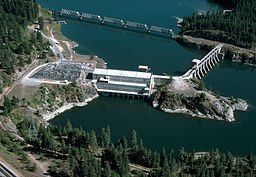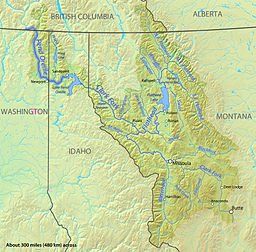Naming and Taming of Albeni Falls
by Charles I. Barker
(revised in 1972, Fielden L. Poirier, Sr. Updated & edited for space available in 2002 by Barb Hornby)
One hundred ninety-four years have gone down in history since the first white man viewed and explored what is now known as Albeni Falls, located on the scenic Pend Oreille River between Newport, Washington and Priest River, Idaho. As that white man stood on the banks of the river overlooking the falls, he marveled at what he saw. He described it as “a scenic place of nature’s handiwork. Two separate channels of water sunk deep into solid granite divided by a rock island, sluiced through each of the respective channels—the great volume of waters of the river in its mad rush to the sea.”
There is no doubt that the white man would have felt a thrill of joy for the future if he had visualized that, nearly one-and-a-half centuries later, this magnificent piece of nature’s scenery would be revised by the hand of man. It would be harnessed and put to work for the betterment of mankind. The man in question was David Thompson. He was an engineer and explorer who was employed by the Northwest Fur Company, which built a fur trading post on Pend Oreille Lake near Hope, Idaho in 1808.
Upon completing the Kalispellem House trading post, Thompson named the lake and river “Kalispellem”. However, several years later some French Canadian trappers came in, and not knowing the river and lake had already been named, renamed it the “Pend Oreille Lake and River.” Thompson’s next mission was to explore the Pend Oreille River, to ascertain if it was navigable by boat to the Columbia River, as a means of transporting their furs to Astoria, Oregon. After reaching Box Canyon, the explorers decided that the waters of this canyon were too treacherous and swift to navigate by boat. The men retraced their steps and left the Pend Oreille River valley west of the present site of Usk, Washington and traveled over the mountains to the Spokane River where the Spokane House trading post was being built.
The next known white men to visit the falls were Jesuit missionaries, Father Peter Desmet and Hoaakson and their assistants. Upon reaching the site of the falls late in December of 1843, a severe storm was raging. They were compelled to make camp for the winter at the falls where several families of Indians lived in their teepee wigwams nestled among the rocks. This site was the Indians favorite hunting and fishing grounds, and no doubt had been for years prior 1843.
In his diary, Father Desmet described Christmas Eve Mass at the falls. He wrote, “After learning that we would have to remain in camp for the winter, we hastily constructed a Chapel made of poles and covered by skins and grass mats, and we were soon prepared for Christmas Eve Mass.” They had no bells to toll so they fired a musket at intervals. The Indians invited the missionaries to join them in celebrating a Christmas Day feast.
They had killed several deer and caught fish from the river. Father Desmet baked some bread on their outdoor stone fireplace. On Christmas Day the white man and Indian squatted on the banks of the Pend Oreille River and had a feast fit for a king.
In 1883, two young French Canadian brothers, Albeni and Louis Poirier settled in what was then known as Spirit Valley (Blanchard, Idaho). It was located about twelve miles south of the Pend Oreille River. They homestead in the valley and engaged in farming and cattle raising. In 1886 Albeni sold his interest in the Poirier Brothers farm at Blanchard and relocated. He homesteaded the land at the falls on the Pend Oreille River and the area was named for him. Albeni and Louis widened an Indian trail between Rathdrum and the falls and for years this was used to haul supplies. Albeni built a log cabin on the banks of the river and this soon became headquarters for navigation on the river. He built and operated the first ferry on the Pend Oreille River just below the falls. He operated it until one was begun at Old Town, Idaho. Albeni also operated a small hotel, boarding house and saloon for many years as well as farming the meadow land that was to the south of the river. Newport, Washington sprang into existence in 1890 and later became the main port for steamboats and river transportation.
The Great Northern Railroad was built over Albeni Falls in 1892 and trains started to operate in 1893. The railroad ran excursions to the site and picnics were held on the island above the falls. The railroad disturbed the location of Albeni’s home and he was required to move his home from the riverbank. He then built a house on the hill overlooking the river where he lived the rest of his life. When he retired he sold the farm to his son-in-law, George Zimmer. Between 1951 and 1954 Albeni Dam was built by the government. The mighty power of the river was tamed, harnessed and put to work for the betterment of mankind.
Charles I. Barker gathered the history of Albeni Falls. He recorded his personal observations and memories throughout the many years that he spent as a purser on several steamboats
plying the river.
Nearly two centuries have gone by since David Thompson, first gazed at the majestic beauty of the falls on the Pend Oreille River (Kalispellem). Many winters have passed since the missionaries made camp at the falls and spent Christmas with the Indians. A lot of water has gone over the falls since Albeni Poirier homesteaded.
Like in the poem “The Bridge Builder” these early pioneers have crossed the “chasm deep and wide”. Their explorations and efforts have “bridged” an easier path and provided a rich legacy for the generations that have followed. It is a history recalled with amazement for the determination and tenacity that has brought us to where we are today. Hopefully this Christmas will bring each of us the same appreciation for the spirit and beauty experienced by the first encounters of Albeni Falls.
History of Blanchard
-
Earl Rusho About the year 1900 Earl and Frank Rusho purchased the Harry Sammons’ homestead...
List Item 1 -
Charles Cook Shortly after Mr. Poirier’s arrival other homesteaders and squatters arrived. As more people settled in this little valley the community became known as White, Idaho...
List Item 2 -
Away From Worry During World War II, Charles Cook, of Irwin, Pennsylvania, came west and obtained work at Hanford, Washington...
List Item 3 -
Naming and Taming of Albeni Falls One hundred ninety-four years have gone down in history since the first white man viewed and explored what is now known as Albeni Falls...
List Item 4




